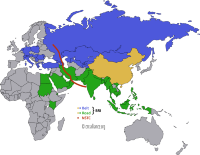India and China are at the brink of war
2017-07-11
(PDFs will be reworked and become available soon)
Since some time china and India are warming up to contain one another China has kicked off Belt and Road Initiative (BRI, also B&R and One Belt, One Road OBOR). This initiative puts China at the heart of the new pan-Eurasian economic order the effort has drawn commitments from over 60 countries and international organizations, and has been described as China’s project of the century.
The massive undertaking consists of 6 corridors and is divided into two main components: the Silk Road Economic Belt (SREB, also „New Silk Road“) and the 21st-Century Maritime Silk Road (MSR). The SREB is a series of overland routes that will collectively connect China with Western Europe through the resource-rich countries of Central Asia. The Maritime Silk “Road”, counter intuitively, refers to a dizzying sea route that flows around Southeast and South Asia, through Africa, and into the Mediterranean.
In counter measures India has a continent-crossing plan of Washington-Tokyo oriented (South-Central Asia policy) which is called North-South Transport Corridor (NSTC), the objective is to link India with Central Asia, Caucasus and Europe thru Iran and possibly Afghanistan. India has been trying to interweave itself deeper within the infrastructural and economic fabric of Eurasia.
The NSTC is a multimodal trade corridor which extends from India to Caucasus, linking the India Ocean and Persian Gulf to Caspian Sea, which lies from Jawaharlal Nehru and Kandla port in western India to the port of Bandar Abbas in Iran, then go road and rail north thru Baku to the Caucasus and beyond. The second route goes along the eastern side of the Caspian Sea, connecting the new Kazakhstan-Turkmenistan-Iran railway to amalgamate with the North-South Transnational Corridor. The third route linking India with Chabahar port of Iran then goes to Afghanistan extends to Central Asia. India is a big driver of enhancements to Iran’s Chabahar port.
India is also backing a road connecting the heart of Afghanistan with a border to Iran, the Kaladan multimodal project in Myanmar – the Trans-Asian Railway (TAR) – which goes all the way from Dhaka to Istanbul and the India-Myanmar-Thailand Trilateral Highway. Possibly, India could develop the Trincomalee port in Sri Lanka as well as Delhi-Kabul Air Corridor in order to bypass and debase Beijing oriented Pakistani Corridor.
In search for supremacy with infrastructure projects in the region, China and India provoke each other
The Stockholm International Peace Research Institute SIPRI warns in his report „The Silk Road Economic Belt“ from early 2017, tension between China and India might build up. Meanwhile, there are some speculations India is considering to deploy around 15'000 soldiers to Afghanistan to deter threats posed by Pakistan and to safeguard its strategic projects in the region. Meantime India and China are pushing the blame game accusing one another for aggressive actions at the border points, which revitalize the Sino-Indian border dispute.
The sovereignty over two large and various smaller separated pieces of territory have been contested between China and India. The westernmost, Aksai Chin, is claimed by India as part of Jammu and Kashmir and region of Ladakh but controlled and administered as part of Chinese autonomous region of Xinjiang. The other large disputed territory, the easternmost, lies south of the McMahon Line.
It was referred to as the North East Frontier Agency, and is now called Arunachal Pradesh. The McMahon line was part of 1914 Simla Convention between British-India and Tibet an agreement rejected by China which caused Sino-Indian war in 1962. The border dispute was in somehow resolved in 1996 as part of Confidence-Building measures.
But tension recently has risen as India has stationed sophisticated military hardware at the border, namely after receiving green signals from Washington and Tokyo, meanwhile India accuses China for acts of aggression at border, India claims, that china has ordered its military unites to be positioned at the crossing line, therefore India has taken reactionary steps.
The delicate situation of smaller countries
According to the geo-strategic spot of some smaller countries – e.g. Afghanistan – each country would be in one way or the other involved in struggle of leadership between Delhi and Beijing. In one hand there is America-Japan-India pact which is to be coming to existence, on the other hand China-Pakistan-Russia accord makes its way forward.
It is really inflexible for the landlocked country such as Afghanistan to position itself between the above said giants. If Afghanistan complies with Chinese initiative, it will risk the loss of its strategic partners; America, India and Japan. Afghanistan totally depends on Washington and in somehow on Delhi without the direct assistance of Washington and Delhi Kabul regime would collapse in a twinkle eyes.
In addition America is critically in opposition to Chinese initiative (BRI) according to the intelligence speculations since China is endeavoring for the Dedollarization of world market – which contradicts the national interest of America and its allies. It is assumed to be strategic threat to global forward policy of America. If Afghanistan obeys Indian initiative which backed by Washington and Tokyo, the nation will face serious security challenges as part of China-Pakistan-Russia counter measures. These countries would thrust their military and political proxies to overthrow the Washington and Delhi backed regime in Kabul.
In this concern, Kabul needs solemn diplomatic steps to take in order to establish proper balance between the two giant blocs. Kabul lacks diplomatic capacity to portray the national interest of the country and meantime to balance, the relations with the two gigantic, geo-economic & geo-political initiatives. It requires a third neutral state or no-state entity to play “Shuttle-Diplomacy” to pursue national interest of the country in one hand on the other institute steadiness amid the mentioned Blocs.
Germany actively support an independent Afghanistan, but is not perceived as a neutral party due to its connections with the USA and the arms deals in the Near East. As per the assessments of the Counter Narco-Terrorism Alliance Germany, the state of Switzerland would be a better choice to carry out the shuttle-diplomacy for Afghanistan. Switzerland has proven its neutrality to resolve numerous disputes among scores of countries; the nation has hosted several dialogues among number of governmental and non-governmental bodies for decades.
Afghanistan necessitates rethinking and reformulating of its foreign policy objectives to put up with national interest of the nation and the interest of its strategic allies.

